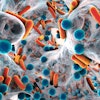
If you're using wet wipes to disinfect surfaces, it may be time to rethink your infection-control product. Rella Christensen, RDH, PhD, named the best disinfectant products and strategies at the recent 2018 Chicago Dental Society Midwinter Meeting, and wet wipes didn't make the cut.
Instead of wipes, dental teams should opt for products that are sealed from air, Christensen noted during her well-attended lecture. Her lab has tested the killing ability of hundreds of disinfectants to find the ideal products for dental use.
"Infection control is probably the most product-dependent discipline in dentistry," Christensen said during her presentation. "You can't manage just by your technique alone. You've got to have effective products."
Finding the right products
 Rella Christensen, RDH, PhD.
Rella Christensen, RDH, PhD.A disinfectant is just a chemical that kills microorganisms, Christensen explained. Her lab, Technologies in Restorative and Caries Research (TRAC Research), regularly tests how well dental disinfectants kill microbes.
An effective disinfectant should be able to kill organisms in fresh, human blood within three minutes, she said. An ideal one should be able to do it in 30 seconds.
TRAC Research has set its effectiveness threshold at a three-log (or 1,000%) reduction of the number of organisms in fresh, human blood within three minutes. Out of all the products the lab has tested, only BioSURF by PureLife Dental and GermXtra by Germiphene meet the recommended ratio. GermXtra isn't sold in the U.S.
"BioSURF is the most recent and the best disinfectant we have tested in 50 years," Christensen said. "And we have tested 200 disinfectants from countries all over the world."
Some of the other tested disinfectants include popular brands, such as Lysol Brand III (Reckitt Benckiser) and CaviWipes (Metrex). Most disinfectants don't meet the lab's threshold because they claim a 10-minute kill time, Christensen noted.
"In a clinical facility, you've got to clean and kill at the same time," she said. "I know you don't leave your counters wet for 10 minutes. That's why we would like a 30-second kill."
BioSURF works well partially because of its packaging. The product comes in what is essentially a wine bag and box, which preserves its potency. Other effective packaging types include aerosol cans and independently sealed packets, but not exposed wipes or spray bottles.
"You can't have a piece that dispenses, and you can't have it out in the open," Christensen said. "You can't have in the presence of air."
Use an effective strategy
Once you have an effective disinfectant, you must also use it properly. Christensen outlined a four-step method to effectively clean surfaces:
“You can't manage just by your technique alone. You've got to have effective products.”
- Directly and liberally pour the disinfectant onto a peach-sized wad of cloth or other cleaning material.
- Spread the disinfectant evenly and continuously on surfaces.
- Leave surfaces wet for as long as possible to allow time for the disinfectant to kill microorganisms.
- Wipe down surfaces with a wet paper towel to make them shiny and even looking.
Christensen also noted some common problems with disinfectant routines. For instance, prewetting wipes can be problematic, because exposing cleaning solution to air throughout the day reduces its potency. She also cautioned against using spray bottles.
"It's like rain on the sidewalk," she said. "You have dry areas and wet areas, so you have to wipe and thereby cut the contact time."
If you're going to use a bottle, Christensen recommended using a pump bottle, rather than a spray bottle. For best results, fill the pump bottle in the morning and use the entirety of its contents by the end of the day.
Finally, it's important to remember that disinfecting properly is more than just about going through the motions. It's about protecting yourself and your patients.
"The infectious people do not tell me," Christensen said. "I've had some very nice people look me in the eye and lie because they're ashamed. You have to be very, very careful to protect yourself and your subsequent patients."



















